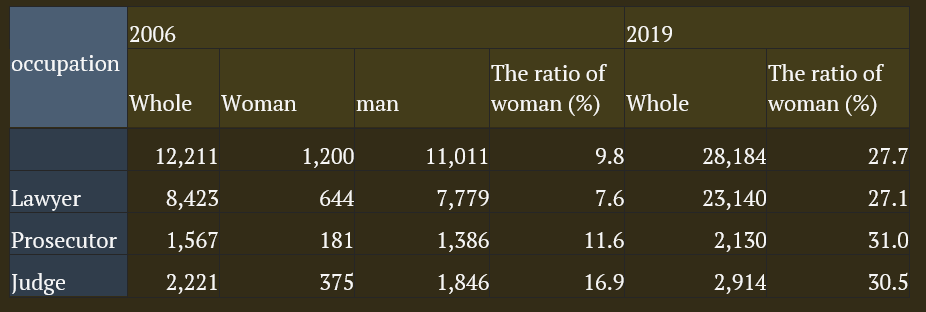Introduction
The marriage rate in Korea is decreasing. According to data released by the Korea National Statistical Office, the marriage rate in the 1995s was 430,000 and the marriage rate in the 2021s was 190,000. The marriage rate dropped sharply by 240,000 over 27 years. In 1995, Koreans married in their mid to late 20s, which was the peak period of 1970-1974, when the number of births reached one million. Therefore, statistically, it is argued that the decrease in the marriage rate due to the decrease in the population is a natural cause. However, even if the decrease in the population is excluded, the decrease in the marriage rate is a rapid situation, and the reason is explained in various aspects.
The status of a woman
With socioeconomic changes, women are more educated and more economically independent. According to a survey conducted by the Korea Women’s Policy Institute, the proportion of female legal professionals steadily increased from 9.8% in 2006 to 27.7% in 2019. With the rise of women’s status in law and various professions, it can be explained that women now pursue self-development and careers for themselves, and marriage is no longer essential for women.

(https://gsis.kwdi.re.kr/statHtml/statHtml.do?orgId=338&tblId=DT_1HB1109N)
Experts also cite the heavy responsibility created by marriage as the reason for hesitating marriage. They start to think about where to get to know their spouse’s family, where to get married, where to go on a wedding trip, where to go to the wedding hall, and whether to have a baby. Women who plan to have a baby are using a system called parental leave because it is difficult for them to work and take care of their children at the same time. However, according to the “2019 Survey on Economic Activity for Women with Career Disruption” released by the Ministry of Gender Equality and Family, 43.2% of the respondents said that the parental leave system is difficult to act as an absolute system to prevent career disruption.
Moreover, the increasing pressure on work and workplace performance makes it difficult to maintain and move forward with family life. The increased social and economic status of women has also made it more difficult to find a suitable partner for two groups at the opposite ends of the marriage market: highly educated, high-earning women and low-educated, low-income men.
Increase in the age of first marriage
Even considering the decrease in the population, the decrease in the marriage rate is steep. In 1995, on average, men married a 28-year-old woman at the age of 25, while men married a 33-year-old woman at the age of 31. The first marriage age is delayed by about 5 years, and marriage begins in the early 30s, and the increase in the first marriage age also affects the decrease in the marriage rate. Professor Jung and Chang-Mu argued that the increase in the first marriage age causes various social problems such as low birth rate, aging, a shrinking economy, pension depletion due to weakening pension burden capacity, and reducing welfare benefits for the elderly.
It may be thought that the decrease in the marriage rate naturally decreases due to the decrease in the population, but when it is confirmed that the first marriage age has risen, there is a major cause of hesitation other than the decrease in the population. The Federation of Korean Industries compared and analyzed the marriage rate and fertility rate according to the employee’s special letter, with the marriage rate 1.65 times that of non-regular workers, 1.43 times that of SMEs, 1.89 times that of non-regular workers, and 1.37 times that of SMEs. According to this, economic stability plays an important role in determining marriage, and the first marriage age has risen to the early to mid-30s, which enjoy an economically decent standard of living, compared to marriage in the mid to late 20s.
According to a study report on gender role values and attitudes toward marriage and children published in the Health and Welfare Forum of the Korea Institute for Health and Social Affairs, men generally think they should consider their economic conditions first, but women think of their spouses’ economic aspects as a more important criterion. The reason why economic requirements are an important consideration is that even if office workers collect their salaries, they often cannot afford to find a honeymoon house. In addition, the reason for the increase in the number of couples who do not have children is that it is difficult to cover all the costs of raising children. Buying a home is a prerequisite for marriage. But many young couples simply don’t have the money to pay for an expensive property – and not every parent has enough savings to help out.
Conclusion
The wedding ceremony of actor Hyun Bin and Son Ye-jin, which was popular for the drama Crash Landing on You in March this year, was also reported by overseas media, and the cost of the wedding hall became a hot topic. Wedding reservations at luxury hotels such as Lotte Hotel Seoul, Hotel Shilla, and Walkerhill are so popular that they can be made in the second half of next year or the second half of next year, despite the basic tens of millions of won and the flower prices that decorate the wedding hall vary widely. The phenomenon of preference for luxury wedding culture continues to be popular despite a decrease in the marriage rate. The wedding demand and Korean wedding culture, which have been dampened by COVID-19, are like showing the reality that only people with economic power can marry. According to the 2021 marriage and divorce statistics released by the Korea National Statistical Office, the number of marriages is 193,000, and 3.8 people are married per 1,000 people. In the future, only economically viable and professionally stable people will be able to get married and have children in Korea. Economic power and stability play an important role in creating and maintaining a family. Accordingly, the government should encourage marriage by introducing policies other than parental leave to create stable families, and should create subsidies and incentives policies even after marriage.
References
Chang-Mu, J. (2008). Age at First Marriage and its Determinants in Korea. [online] pp.1–14. Available at: https://s-space.snu.ac.kr/bitstream/10371/7287/1/kpat_200808_010.pdf [Accessed 7 Nov. 2022].
Gan, N. (2021). Chinese millennials aren’t getting married, and the government is worried. [online] CNN. Available at: https://edition.cnn.com/2021/01/29/china/china-millennials-marriage-intl-hnk/index.html [Accessed 10 Nov. 2022].
Jong seo, P. (2021). 2021년도 가족과 출산조사. pp.1–444.
National Statistical Office (2022). KOSIS. [online] kosis.kr. Available at: https://kosis.kr/statHtml/statHtml.do?orgId=101&tblId=DT_1B83A05 [Accessed 7 Nov. 2022].
www.fki.or.kr. (2022). 전국경제인연합회에 오신 것을 환영합니다. [online] Available at: https://www.fki.or.kr/main/news/statement_detail.do?bbs_id=00034721&category=ST [Accessed 7 Nov. 2022].
www.korea.kr. (n.d.). 2018년 혼인·이혼통계. [online] Available at: https://www.korea.kr/news/policyBriefingView.do?newsId=156322354 [Accessed 7 Nov. 2022].
